#nepenthes bicalcarata
Text

Nepenthes bicalcarata.
59 notes
·
View notes
Text

Nepenthes bicalcarata by Bruce Frye
20 notes
·
View notes
Text
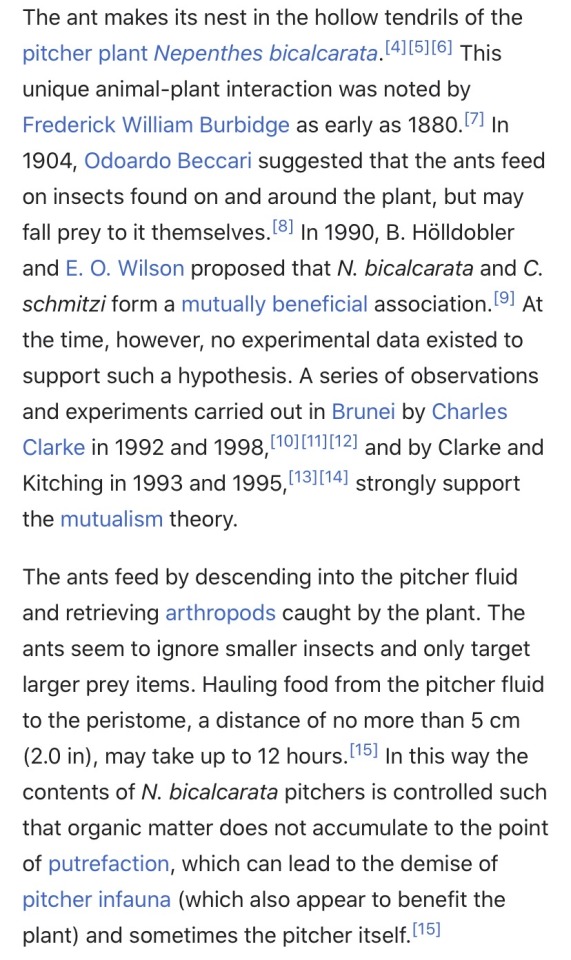
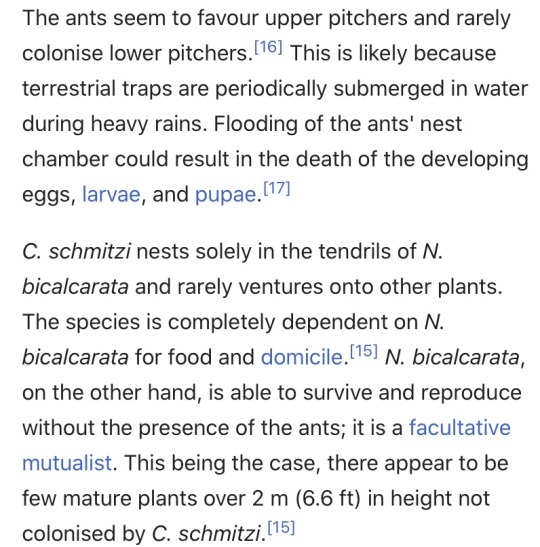
what if... i was a tiny ant... and u were an insectivorous plant... but u let me have some of ur food and live in ur tendrils... ahaha jk... unless?
#im fucking completely obsessed w this now#and the plant looks like a fucking chubby vampire#pitcher plant#biology#nepenthes bicalcarata#c. schmitzi
3 notes
·
View notes
Text
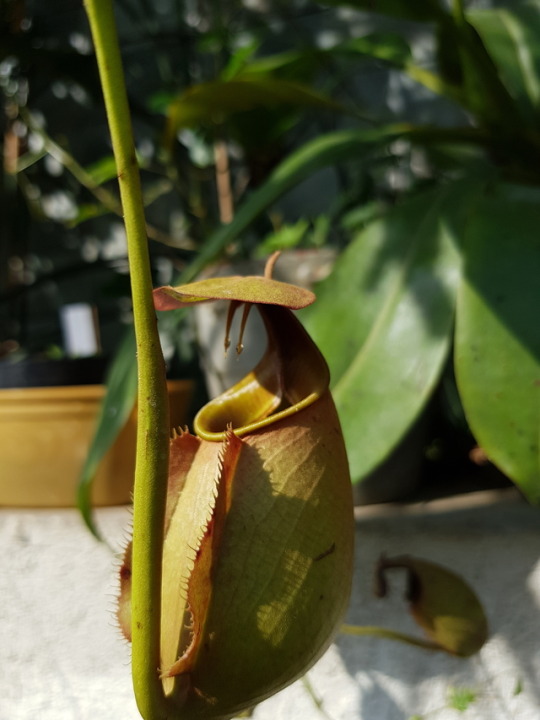
A brief non-fandom post: First time I got a shot with nectar oozing from the "fangs." The plant uses it to lure insects (mostly ants)
Nepenthes bicalcarata
#pitcher plant#Tropical pitcher plant#carnivorousplant#carnivorous plants#nepenthes#N bicalcarata#Nepenthes bicalcarata#Cool plant#Carnivorous plant
6 notes
·
View notes
Photo
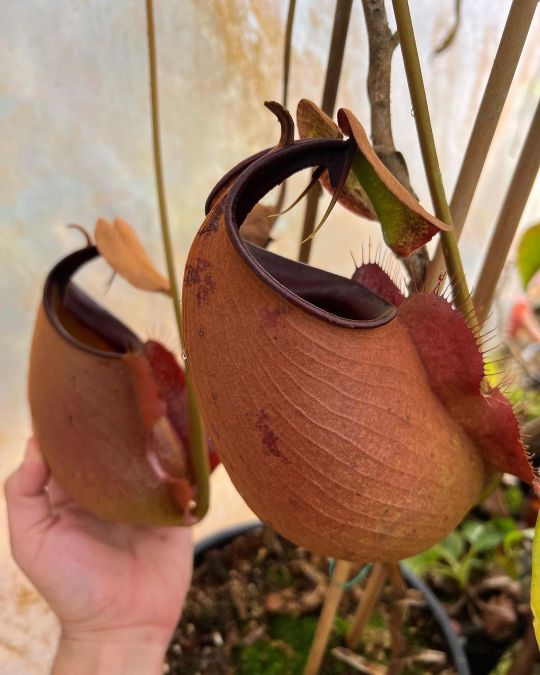
Nepenthes bicalcarata never gets old! . . #Nepenthesbicalcarata #Nepenthes #bicalcarata #botany #botanist #iphone #shotoniphone #exoticaplants #redleafexotics #pitcherplantproject #vscocam #vsco #greenhouse #rare #colorado #colospgs #coloradosprings #carnivorousplant #denver #carnivorousplants #icps #plant #plants #greenhouses #rareplants #pitcherplant (at Colorado Springs, Colorado) https://www.instagram.com/p/Cb6sk4DOHdO/?utm_medium=tumblr
#nepenthesbicalcarata#nepenthes#bicalcarata#botany#botanist#iphone#shotoniphone#exoticaplants#redleafexotics#pitcherplantproject#vscocam#vsco#greenhouse#rare#colorado#colospgs#coloradosprings#carnivorousplant#denver#carnivorousplants#icps#plant#plants#greenhouses#rareplants#pitcherplant
17 notes
·
View notes
Photo
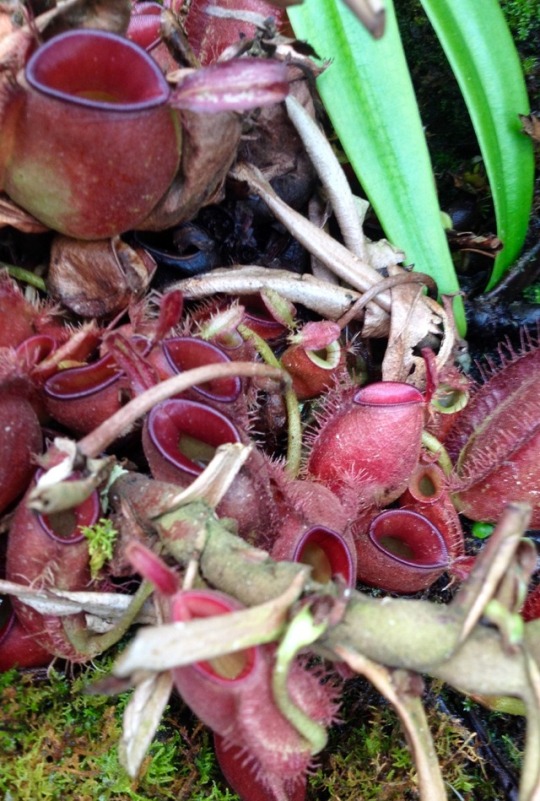
Nepenthes bicalcarata x ampullaria Some of these pitchers are soooo small that a housefly wouldn't even be able to squeeze inside 🔎🔎🔎
#nepenthes#neps#carnivorous plants#cps#pitcher plant#ampullaria#bicalcarata#insects#plants#grow#garden#greenhouse#tropical#botany#horticulture
291 notes
·
View notes
Photo
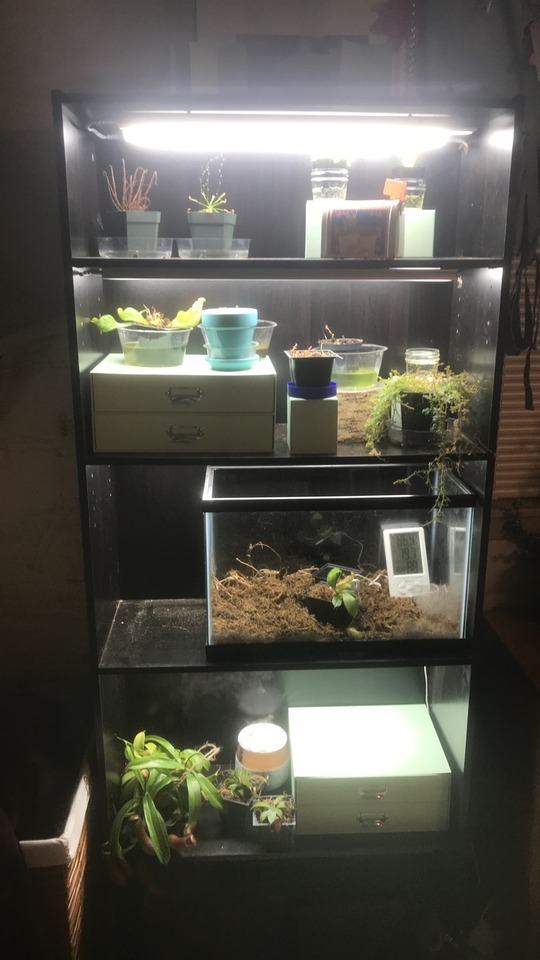
bought a bookshelf and installed some lights to showcase my carnivorous plants :)
#carnivorous plants#nepenthes#drosera#sarracenia#dionaea#utricularia#my two fav plants are struggling with the change :(#i bought a n. bicalcarata and they often get transplant shock and mine had a healthy leaf break off in the mail#and two of the leaves aren't looking hot#hopefully it bounces back i love it and also i've never spent so much money on a plant#and my d. filiformis might've been put too close to the light and i think the leaves got burnt#so it's in a new spot :/#but my new n. x lady luck and n. suki are doing great!#anyways this has been a fixation for the past 6ish months and i'm hopefully buying a new nepenthes today#because i now have a grower in the city because i am Too Much#also i have some cool drosera seeds to propagate this weekend#and today i'm teaching youth all about carnivorous plants#runon post#my plants#also i am v aware that the dionaea and sarracenia should be outside and dormant#but i bought them this winter and i'm experimenting to see if they can skip this year's dormancy and survive#fingers crossed!
1 note
·
View note
Photo
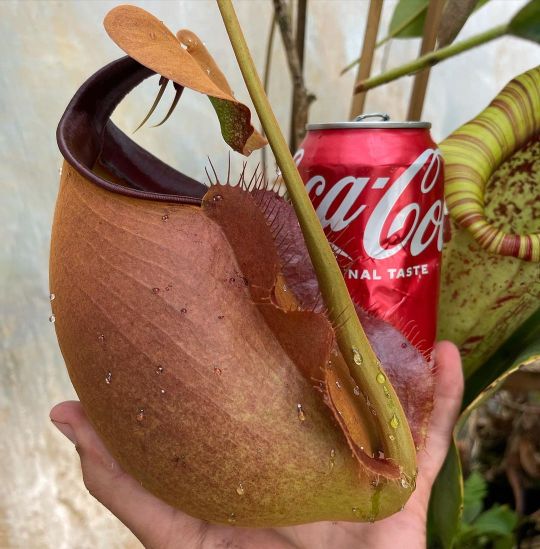
A giant Nepenthes bicalcarata pitcher! Those fangs never get old! . . . #Nepenthesbicalcarata #Fangs #nepemthesfangs #bicalcarata #nepenthes #maneater #plants #botany #botanist #plant #iphone #shotoniphone #pitcherplantproject #greenhouse #carnivorousplant #borenoexotics #carnivorousplants #carnivorousplantsofinstagram #plantsofinstagram #icps #plantsplantsplants #plantsmakepeoplehappy #colorado #colospgsco (at Colorado Springs, Colorado) https://www.instagram.com/p/CSSzlLjL1l3/?utm_medium=tumblr
#nepenthesbicalcarata#fangs#nepemthesfangs#bicalcarata#nepenthes#maneater#plants#botany#botanist#plant#iphone#shotoniphone#pitcherplantproject#greenhouse#carnivorousplant#borenoexotics#carnivorousplants#carnivorousplantsofinstagram#plantsofinstagram#icps#plantsplantsplants#plantsmakepeoplehappy#colorado#colospgsco
0 notes
Photo

Beth Moon (American, b. 1955)
Nepenthes Bicalcarata
93 notes
·
View notes
Photo

Evan Kolker - N. Bicalcarata in Stratera, Nepenthes series, 2014
(Glass, steel, silver flocking)
169 notes
·
View notes
Photo
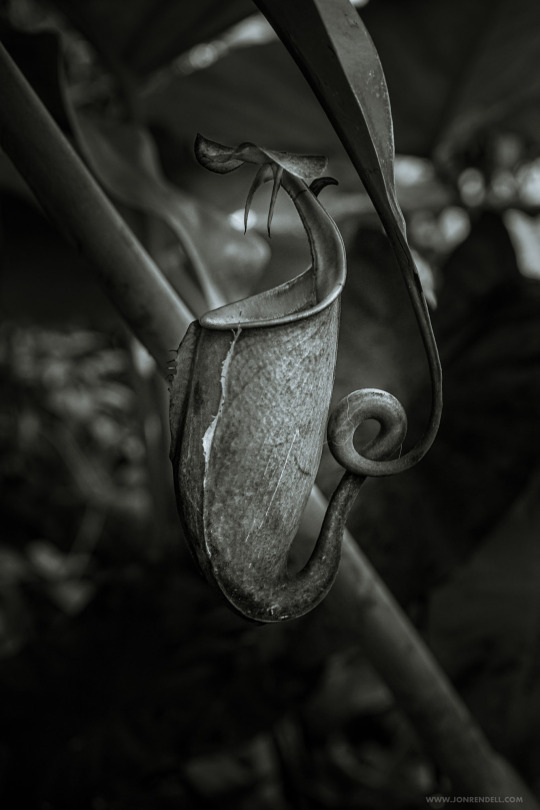
Day 87 — Fanged Pitcher Plant
Nepenthes bicalcarata (from Latin for "two-spurred"), also known as the fanged pitcher-plant, is a tropical pitcher plant endemic to northwestern Borneo, Indonesia.
The two thorns that give N. bicalcarata its name are unique to this species. The purpose of these structures has long been debated among botanists. They might serve to deter arboreal mammals such as tarsiers, lorises and monkeys from stealing the contents of the pitchers.
The fanged pitcher plant is the sole host of a carpenter ant known scientifically as Camponotus schmitzi. The tendrils that hold the pitchers themselves are hollow and serve as nest sites for these ants. Ant colonies take up residence in the tendrils and will hunt along the insides of the pitchers. In fact, they literally go swimming in the pitcher fluid to find their meals!
This is why the pitcher fluid differs so drastically from other Nepenthes. The fanged pitcher plant actually does very little of its own digestion. Instead, it relies on the resident ant colony to subdue and breakdown large prey. As a payment for offering the ants room and board, the ants help the plant feed via the breakdown of captured insects (which are often disposed of in the pitchers) and the deposition of nitrogen-rich feces. Indeed, plants without a resident ant colony are found to be significantly smaller and produce fewer pitchers than those with ants. The ants also protect and clean the plant, removing fungi and hungry insect pests.
56 notes
·
View notes
Text
by the time i notice that i have an email from the plant store the best new plants are almost always sold out
#posting from mobile#i got the email like 4 hours ago and noticed it a few minutes ago#and the nepenthes bicalcarata are already sold out...#i didn't have a good place to put one anyway but like.. they're so cool....#between now and winter would've probably been enough time to buy a space heater and humidifier and trellis for my room#it's perfect climate here for them at this time of year and in spring but it gets slightly cold for them in the house in winter#the biggest challenge would be allowing them space to vine but listen. for a plant that cool? i would be 100% willing to convert like#half of my room into a greenhouse#they've also got drosera prolifera in new and although it isn't sold out i don't have an appropriate growing place for it#curse that dehumidifier. my dresser would be a perfect place for that plant if not for the dehumidifier#my terrarium is more humid than my room but it has too much light for d prolifera#carnivorous plants -
2 notes
·
View notes
Photo

Check out the trap on this fanged pitcherplant (Nepenthes bicalcarata)!!! This unique pitcherplant uses a pair of fangs to produce nectar and lure prey directly above the opening of their traps. Interestingly they also have a symbiotic relationship with a species of carpenter ant, which nest in the hollow tendrils that support the trap. The inside walls of the pitchers are not very slippery and the fluid within is lacking acidity/high enzyme levels which allow the ants to hunt and swim for fallen insects!!! The plant feeds on the the ant's poop and also any remaining insect parts the ants dont want!!🐜🌱 #nepenthesbicalcarata #botany #plantaddict #pitcherplant #neature #plantlife #plantnerd #carnivorousplantclub #plantsofinstagram #macro #urbanjungle #terrarium #carnivorousplant https://www.instagram.com/p/CNK-6U5A2gu/?igshid=ukivpry7metk
#nepenthesbicalcarata#botany#plantaddict#pitcherplant#neature#plantlife#plantnerd#carnivorousplantclub#plantsofinstagram#macro#urbanjungle#terrarium#carnivorousplant
9 notes
·
View notes
Note
pls explain the news in laymans terms 😭
okay lads buckle up, this is gonna be a long one. the paper is “A phylogenomic analysis of Nepenthes (Nepenthaceae)” from Murphy et al. i’m gonna link it here, and i encourage anyone interested to read it for themselves and draw their own conclusions, but otherwise i’m gonna give an overview as i understand it.
if you do not want to see 394023 words of in-depth carnivorous plant genetics content you should start scrolling now.
so. Nepenthes is a carnivorous plant family colloquially known as ‘asian pitcher plants’ or ‘monkey cups’. it’s one of the largest carnivorous plant families in the world, and without a doubt one of the most diverse, but we’ll get to that in a minute. these plants have pitchers that fill with fluid and digest bugs alive (important note in terms of nep anatomy 101: unlike venus fly traps or sundews, Nepenthes are passive traps and don’t move or curl up or anything, just sit and watch it all unfold). their range has china and korea on the northern edge, the tip of australia on the southern edge, and most of indonesia, the philippines, and most associated landmasses encompassed between. there are a couple outliers, but for the most part these are jungle plants with a vining growth form that weaves through trees and just….eats.
now, putting aside the fact that they’re carnivorous, one of the biggest points of Nepenthes is their diversity as a family. if anyone out there remembers the term ‘adaptive radiation’ from an intro bio class, Nepenthes is THE family of adaptive radiation. in addition to common species that grow everywhere in their range, these lads can be so specialized that there are species you can only find on single specific ridges on single specific mountains on single specific islands; as you can imagine, this makes them especially vulnerable to climate change, habitat destruction, and poachers.
the most obvious point of diversity here is the pitcher traps themselves: there are hundreds of different pitcher morphologies, ranging from special peristome adaptations to bizzare patterns and colorations to the addition of fang-like structures and symbiosis with bats, ants, and rodents. the list goes on. these lads are so specialized it’s unbelievable. one might think that, in terms of figuring out how these different species are related to each other, that it would be pretty obvious, since everything is so distinctive.
but there is a problem.
they fuck.
Nepenthes as a family is established to be one of the oldest carnivorous plant families, but the 200+ species identified over the years are suspected to be the result of very recent (in evolutionary time) modern radiation. one of the most common definitions of what a ‘species’ is that i see circulated is the idea that something is a species when it can no longer breed with another species, but it’s important to realize that this is one definition of what a ‘species’ is. in the case of Nepenthes, the knowledge that a bunch of scientists have decided they are different does not stop them.
it was hoped, with the advent of DNA testing, that maybe we would be able to assemble a semi-full map of how all these species relate to one another and how they came to be (a phylogenetic tree), but as it turns out the lads fuck so much between themselves and other Nepenthes species that figuring out how they became the species they became, even with DNA, is extremely difficult. ‘breeding complexes’ not too different than what i wrote about in the fern sex triangle post a while back are a very nepenthes-esque thing to have happen.
a quote from the paper:
“These uncertainties are not unique to Nepenthes but various factors make them important in this group: the frequency of natural hybrids and apparent lack of intrinsic reproductive barriers between taxa, the extent of intraspecific morphological variation and the reliance by taxonomists on the pitchers.”
in short, these plants have no control. they are not practicing safe sex. they are living lavishly in their own tropical jungle paradise with as much hedonism as a plant can muster as botanists try to connect how one pitcher might be the evolutionary origin of another while somehow all the pitchers are either functionally the same or radically different.
which brings us to this study. when people compare DNA, they’re rarely comparing the entire genome (although that can be done), but rather they identify a set of consistently mutable genes that are present across an entire subsection of life, and look at just those genes at just their locations on various chromosomes. instead of trying to find a couple genes fit to compare plants across the Nepenthes genus, as past studies did, this study took and applied a set of DNA probes developed previously to compare 353 genes present across the entire subkingdom of flowering plants.
as you can imagine, this provides a significantly larger set of data to work with. sure, it’s not perfect and this take will need more research to confirm (basing the entire Nepenthes phylogenetic tree off of a single study is a dangerous game, especially when things are so saucy in the forest), but it’s significantly better than the results past Nepenthes phylogenetic analyses generated, where researchers were able to see some general outlines and attempted to sort the genus into a few groups, but were ultimately unable to see where species themselves split and what their relations to each other were (you know, because of all the sex).
so. this paper:
-obtained samples from 151 different Nepenthes species from different collectors, herbariums, and conservatories. for those familiar with Nepenthes as a hobby, Andreas Wistuba might ring a bell; he contributed some samples from his plants to this study. otherwise, the KEW botanical gardens is more ubiquitously recognized donor.
-for more common species, more samples were taken from different places to account for different populations.
-another quote from the paper that i think is interesting on multiple levels: “We also include two unpublished species, N. sp. Anipahan and N. sp. taminii. The former, from Palawan, is discussed by McPherson (2011) and may be a synonym of N. leonardoi. The latter is an undescribed species from Sumatra that has been circulating amongst Nepenthes growers and resembles N. rhombicaulis but is perhaps distinguished by its leaves. Also sampled here are N. echinostoma Hook. f., a commonly collected plant usually considered a variant of N. mirabilis, and a sample we liken to N. angustifolia Mast., a species usually considered synonymous with N. gracilis.”
i mentioned earlier that previous molecular analyses done by other people were able to see a general outline but weren’t able to see anything more distinct; the results of this paper for the most part confirm these general outlines, which means that if nothing else we have strong support for the relationship the entire Nepenthes family has to other, more closely related plant families, which the paper resolves in this tree:
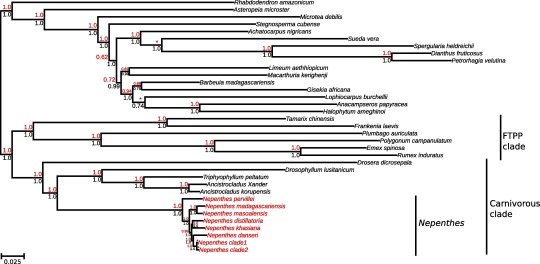
note that the above tree describes the family’s relation to various other families, followed by ‘Nepenthes clade 1′ and ‘Nepenthes clade 2′. these two clades contain most of the Nepenthes genus sampled; the six species shown in red, according to the results, are considered sister species to the entire rest of the genus, separate from those two clades.
now, what personally gets me the most excited here is the plant they confirmed as being the sister species to that subsection of sister species, effectively making it the outgroup to like, literally everything else: Nepenthes pervillei, from the republic of seychelles.
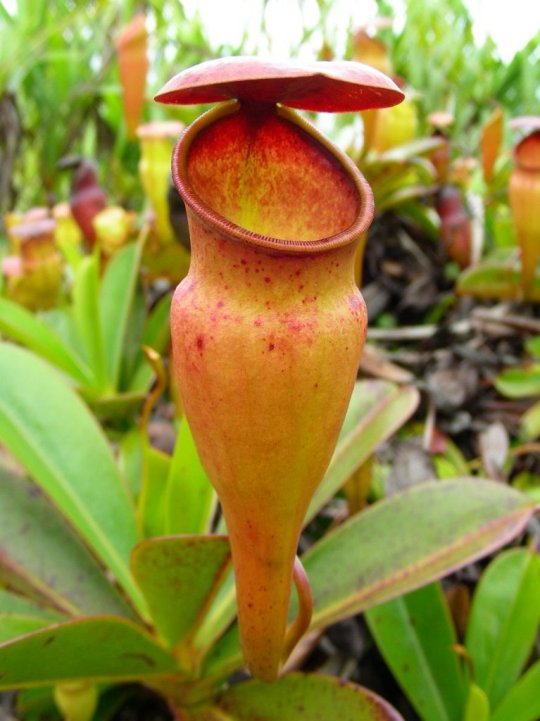
yeah. you know back at the beginning of this response when i said there were some exceptions to the Nepenthes habitat range? this would be one of those exceptions. the republic of seychelles is off the coast of africa, closer to madagascar than indonesia. to be fair, there are also Nepenthes along the eastern coast of madagascar, but because Nepenthes is so strongly geographically coordinated (this paper goes on to describe clades literally just named after the countries they’re in) this is pretty goddamn cool. this species got cut off in the middle of the ocean and now looks…….like a Nepenthes, but just off enough to be kind of weird (the biggest thing i realized just…staring at pictures of it is that it doesn’t seem to have wings down the front, which to be fair isn’t required of neps but makes it look super naked as a result). forbidden uncanny valley Nepenthes cast from the fuck zone. i love it.
the other main outgroup species (the sister species to all the ‘typical’ asian species, specifically, aka clades 1 and 2) they identified was Nepenthes danseri, which is native to waigeo island in indonesia (that’s in the fuck zone, for those keeping score at home) and, i would argue, has the same kind of thin-peristomed, simple-ribbed kind of look to it that pervillei has, but it definitely looks more traditionally Nepenthes-like.
now, with that, we really get into the meat of their results here. this is the full phylogenetic tree with all tested species laid out according to their results:

i….have no idea if tumblr will let you zoom in on this pic so im just gonna write down some notes.
the color-coded names on the tree to the right match their respective habitats down in the map on the bottom left, which is neat, but it’s also interesting to see how some of these species have apparently been fucking between islands. i know this is gonna be low-res but look at this swath at the top, some of what they’ve identified as being ‘clade 1′ (mostly common, widespread lowland species):
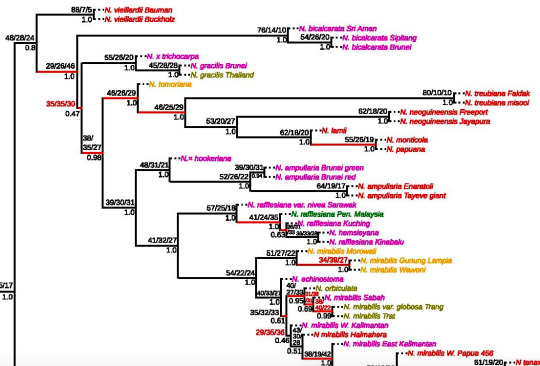
- man………. i mean, first of all i wanna point out the lone bicalcarata branches at the top #representing, having somehow maintained their chastity despite being the sexiest of the Nepenthes.
- hookeriana being the outgroup for ampullaria seems to fit well by adorable chubbiness factor alone.
- one thing that seems weird but not totally out of character is that halfway down in yellow we see mirabilis in multiple populations in yellow, then down from there a little ways we see different mirabilis populations in green and purple and red, all but N. echinostoma and N. orbiculate, which are both outgroups. i knew it was a common species, but for some reason i wasn’t expecting it to be like………that (there’s an entire second section of them in red just below where this screenshot cuts off). like, good for them.
going down the main tree, we get into clade 2, the more specialized highland species, which are always very exciting.
there’s my personal favorite, N. villosa:

not surprised at N. edwardsiana’s relation, because how else would you be able to achieve such absolutely enormous teeth, but N. macrophylla surprises me. it’s got good teeth, but both edwardsiana and villosa are like, TEETH, you know? i guess it makes sense that it split from villosa, though.
moving from that, VERY glad that the littlest known lad, N. argentii, made it on here. i know i’ve talked about argentii on this blog before, as the Nepenthes species that was so tiny the paper describing it’s discovery warned that population counts could be skewed by the plants ‘hiding under bushes’. their tinyness, which kills me every time i look at an image of them, is somehow weird in terms of being related to N. graciliflora, which is…..pretty normal sized. same with N. armin. makes me wonder how the hell they got so tiny.

of course we can’t leave out the group with the largest currently known species, N. attenboroughii. the hilarity of the smallest and largest Nepenthes species being a single clade apart, if not very distantly diversified down their respective evolutionary lines, is not lost on me.

N. palawanensis is a chonker, but i gotta say i wasn’t expecting it to be the sister species to the one and only megachonker, the plant literally famous for its sheer chonk. imagine being that overshadowed by your sibling.
on a more general note– the paper noted this, too –it’s interesting to see how the lowland species seem to be happier about jumping islands and being promiscuous than the highland species, which seem to clump together by location. i guess it’s not surprising, knowing how specialized some of these highland species can be; villosa, for example, is native to a single side of a single mountain, and is positioned so that the populations are hit by cool wind coming up from the sea. still, lowland species need hot and humid environments, and can be just as picky. it’s gotta be a matter of isolation.
anyway, there’s probably more i could talk about here but…man there’s a lot of data. the paper goes in-depth with how they constructed the more problematic branches, and trouble they had with some over others, confirming that we shouldn’t take this phylogenetic tree as 100% correct; things will almost certainly change or become clearer as more research is done, and phylogenetic trees in particular are known for being constructed and reconstructed time and time again.
still though, it’s like…to see these relationships at this resolution for the first time is just really fucking cool, man. this isn’t even all the species. i remember i went to a carnivorous plant conference two years ago now, and there was a lecture by researchers attempting to untangle the phylogeny of Nepenthes and coming up short aside from a low-resolution tree of some of the more major species and the relation of Nepenthes to other families, their science blocked by the sheer feral chadness on display in the tropical jungles encompassing the land between china and australia. like, i really just want to take a moment, as an end note, to appreciate that these plants fucked so much in the past couple million years that it took multiple major advancements in technology and the examination of hundreds of genes just to get an approximate look at the phylogeny. like, that’s an Isoetes level power move and im not over it
#Anonymous#long post#me reading a new nepenthes paper: *sight narrows into a tunnel* *writes for two hours*#nepenthes#carnivorous plants#asks#plont asks
489 notes
·
View notes
Text

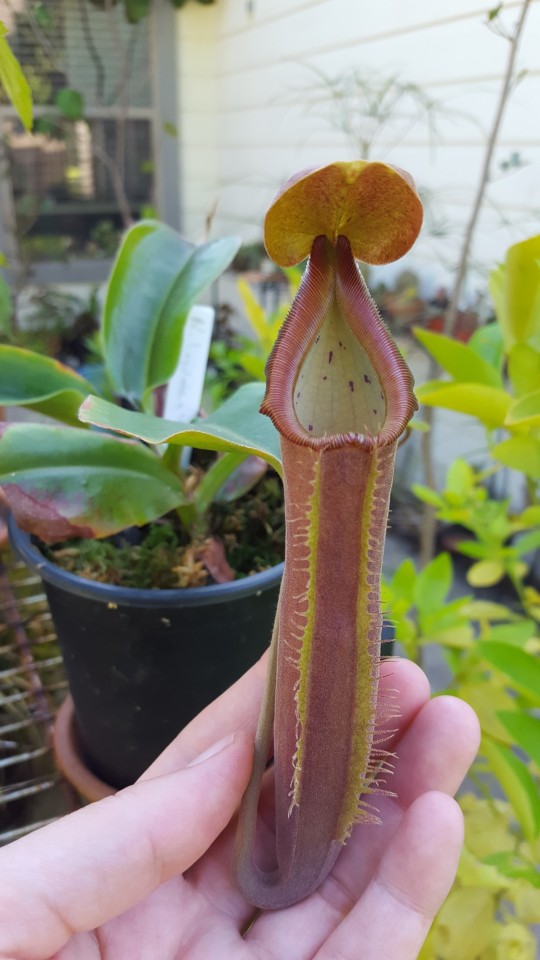


This is the nepenthes I posted a few days ago, a hybrid between N. lingulata and N. truncata Red. N. truncata, as discussed previously, chiefly contributes increased pitcher size. N. lingulata is an interesting dark species with a charcoal body and black peristome. Its name derives from a long dangling structure on the underside on the pitcher lid, which has nectar glands at its base. This appendage likely serves to direct insects to the opening of the pitcher, similar to the fangs of N. bicalcarata. N. truncata has no such structure, and so their hybrid bears only a small nub towards the base of the lid. (Similarly, bicalcarata's fangs tend to be greatly reduced in its hybrids.) It's a vigorous grower and doesn't seem to mind warmer temps and less than ideal humidity. Pitcher color will darken as it ages.
20 notes
·
View notes
Photo
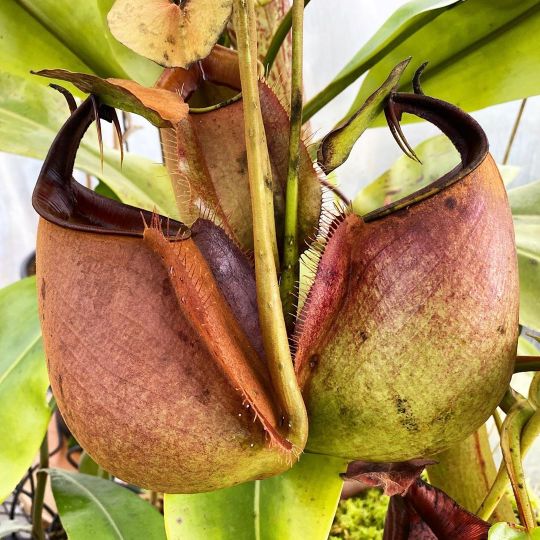
3 of a kind! 3 fanged pitchers, Nepenthes bicalcarata is one of the best lowland species! It’s so big it was hard to get 3 pitchers in one shot! . . . . . . . . . #nepenthesbicalcarata #bicalcarata #fang #plantsplantsplants #nepenthes #plants #botany #botanist #plant #pitcherplantproject #vscocam #vsco #greenhouse #rare #colorado #colospgs #coloradosprings #carnivorousplant #bbc #nationalgeographic #denver #carnivorousplants #carnivorousplantsofinstagram #plantsofinstagram #carnivorousplantclub (at Colorado Springs, Colorado) https://www.instagram.com/p/CEKB6Pxloxo/?igshid=1syls42g304nn
#nepenthesbicalcarata#bicalcarata#fang#plantsplantsplants#nepenthes#plants#botany#botanist#plant#pitcherplantproject#vscocam#vsco#greenhouse#rare#colorado#colospgs#coloradosprings#carnivorousplant#bbc#nationalgeographic#denver#carnivorousplants#carnivorousplantsofinstagram#plantsofinstagram#carnivorousplantclub
4 notes
·
View notes